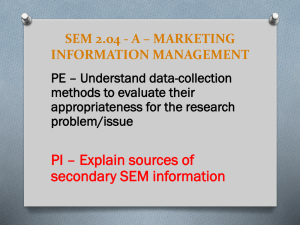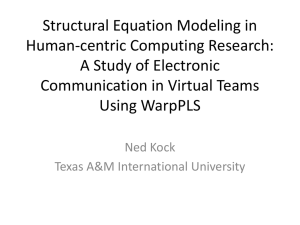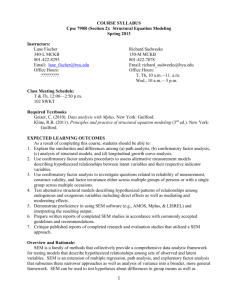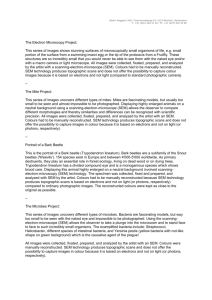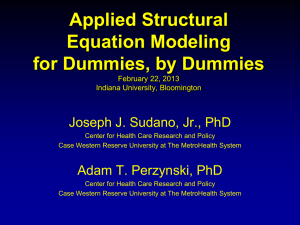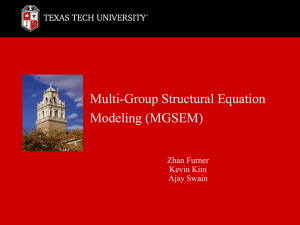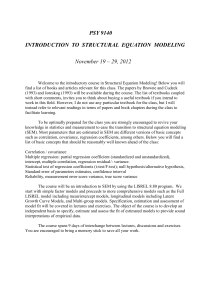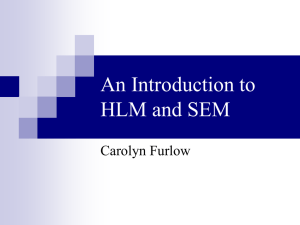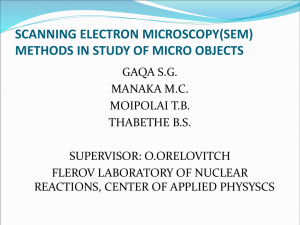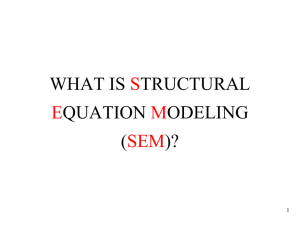Structural Equation Modeling (SEM)
advertisement
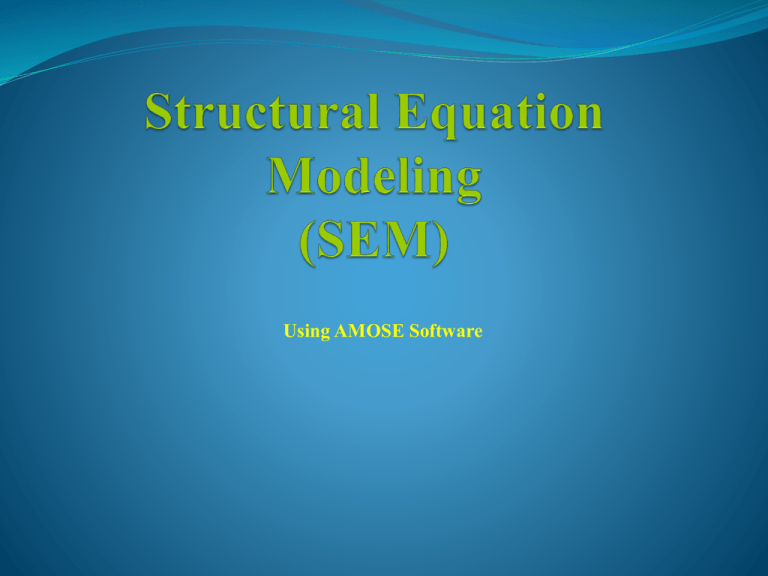
Using AMOSE Software What Is Structural Equation Modeling? Structural Equation Modeling (SEM) is a multivariate technique that combining aspects of (a) multiple regression (examining dependence relationships) and (b) factor analysis (representing unmeasured concepts – factors – with multiple variables) to estimate a series of interrelated dependence relationships simultaneously (Hair, Anderson et al. 1995). It is a statistical technique that allows the analyst to examine a series of dependence relationships between exogenous variables and endogenous variables simultaneously. SEM is an extension of the general linear model (GLM) that enables a researcher to test a set of regression equations simultaneously. Why SEM? The usefulness of SEM in research is distinguished by following characteristics: SEM programs provide overall tests of model fit and individual parameter estimate tests simultaneously Regression coefficients, means, and variances may be compared simultaneously, even across multiple between-subjects groups. It improves statistical estimation by accounting for measurement error in the estimation process. It is able to represent unobserved (latent) concepts in the analysis of dependence relationships. The basic approach to performing a SEM analysis is as follows: Theory Model Construction Instrument Construction Interpretation Data Collection Model Testing The researcher first specifies a model based on theory, then determines how to measure constructs, collects data, and then inputs the data into the SEM software package. The package fits the data to the specified model and produces the results, which include overall model fit statistics and parameter estimates. Results http://ssc.utexas.edu/consulting/ AMOS Stands for Analysis of MOment Structures Moment structures refer to: :: Mean :: Variance :: Covariance A computer application under SPSS Use graphical interface SEM Terminologies Manifest or Observed variables: it is a variable that directly measured by researchers Latent or Unobserved variables: it is a variable not directly measured, but are inferred by the relationships or correlations among measured variables in the analysis. Examples: Quality, perception, attitude, values, image SEM Terminologies Exogenous (IV): an exogenous variable is one whose variability is assumed to be determined by causes outside the causal model under consideration(Pedhazur,1997) . Endogenous (Dependent and Mediating variables): is one whose variation is to be explained by exogenous and other endogenous variables in the causal model SEM Terminologies Measurement Model: The measurement model specifies the rules governing how the latent variables are measured in terms of the observed variables, (Decide which manifest variables define each latent variable) and it describes the measurement properties of the observed variables. That is, measurement models are concerned with the relations between observed and latent variables. (Ho, 2006). SEM Terminologies Structural Equation Model: is a flexible, comprehensive model that specifies the pattern of relationships among independent and dependent variables, either observed or latent. It incorporates the strengths of multiple regression analysis, factor analysis, and multivariate ANOVA (MANOVA) in a single model that can be evaluated statistically. Moreover, it permits directional predictions among a set of independent or a set of dependent variables, and it permits modeling of indirect effects (Ho, 2006). Checklist of Requirements in SEM Reasonable Sample Size: “sample size is sufficiently large” Ho (2006)The most appropriate minimum ratio is ten respondents per parameter Kline (2005, 2010) - N <100 small; N between 150 and 200 medium; N >200 large; but perhaps even 200 case is insufficient to analyze more complex models. - Thus 20 cases for every estimated parameter is ideal although 10 subject per variable is less ideal, but may suffice(Kline, 2005). James Stevens’(2002) a good general rule for sample size is 15 cases per predictor Schumacher and Lomax (2010) cited from Costello and Osborne (2005) 20 subjects per variables is recommended for best practices in factor analysis. Number of indicator variables: As a practical matter, three is the preferred minimum number of indicators, and in most cases, five to seven indicators should represent most constructs (Hair et al., 2006). Assumptions in SEM Observations are independent of each other. Random sampling of respondents. Linearity of relationships between exogenous and endogenous variables. Distribution of observed variables multivariate normal (Ho, 2006). is Normality As a rule of thumb, discrete data (categorical data, ordinal data with < 15 values) may be assumed to be normal if skew and kurtosis is within the range of +/- 1.0 (some say +/- 1.5 or even 2.0) (Schumacker & Lomax, 2004: 69). In fact, residuals from a SEM analysis are not only expected to be univariate normally distributed, their joint distribution is expected to be joint multivariate normal (JMVN) as well. However, this assumption is never completely met in practice. Goodness-of-Fit Criteria Goodness-of-Fit measures can be classified into three types (Ho, 2006): (1) Absolute fit measures: These measures determine the degree to which the proposed model predicts (Fits) the observed covariance matrix. Some commonly used measures of absolute fit such as: a) Chi-square: In SEM, the researcher is looking for significant differences between the actual and predicted matrices. As such, the researcher does not wish to reject the null hypothesis and, accordingly, the smaller the chi-square value, the better fit of the model. b) Normed Chi-square/df: Values close to 1.0 indicate good fit. values between 2.0 and 3.0 indicate reasonable fit. c) Goodness-of-Fit Index(GFI): value > 0.90 d) Root Mean Square Error of Approximation(RMSEA); Hair, et al., (2006; p748) recommended RAMSEA between .03 and .08. Kline (2011, p 206 and 2005, p139) RAMSEA < .05 indicates close approximate fit, between .05 and .08 reasonable, and RAMSEA > .10 suggest poor fit (cited from Browne & Cudek, 1993) -e) Standardised Root Mean-square Residual (SRMR): values less than .10 are generally considered favorable (Kline, 2005, p141) Goodness-of-Fit Criteria (2) Incremental fit measures: These measures compare the proposed model to some baseline model, most often referred to as the null or independence model. In the independence model, the observed variables are assumed to be uncorrelated with each other. Incremental fit measures have been proposed, such as: -Tucker-Lewis Index (TLI) -Normed Fit Index (NFI) -Relative Fit Index (RFI) -Incremental Fit Index (IFI) -Comparative Fit Index (CFI) By convention, researchers have used incremental fit indices > 0.90 as traditional cutoff values to indicate acceptable levels of model fit. the model represents more than 90% improvement over the null or independence model. In other words, the only possible improvement to the model is less than 10%. Goodness-of-Fit Criteria (3) Parsimonious fit measures: In scientific research, theories should be as simple, or parsimonious, as possible (Ho, 2006). parsimonious fit measures relate the goodness-of-fit of the proposed model to the number of estimated coefficients required to achieve this level of fit. Such as: Parsimonious Normed Fit Index (PNFI): When comparing between models, differences of 0.06 to 0.09 are proposed to be indicative of substantial model differences (Williams & Holahan, 1994). Akaike Information Criterion (AIC): The AIC is a comparative measure between models with differing numbers of constructs. AIC values closer to zero indicate better fit and greater parsimony. A small AIC generally occurs when small chi-square values are achieved with fewer estimated coefficients. That’s ALL For the Introduction
